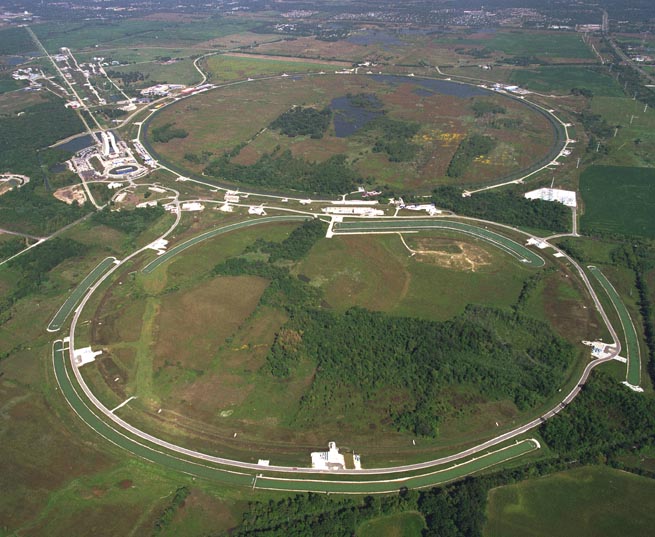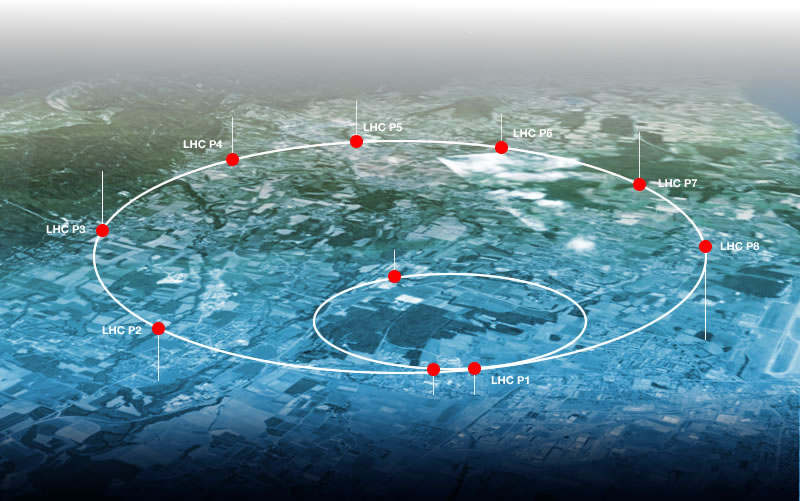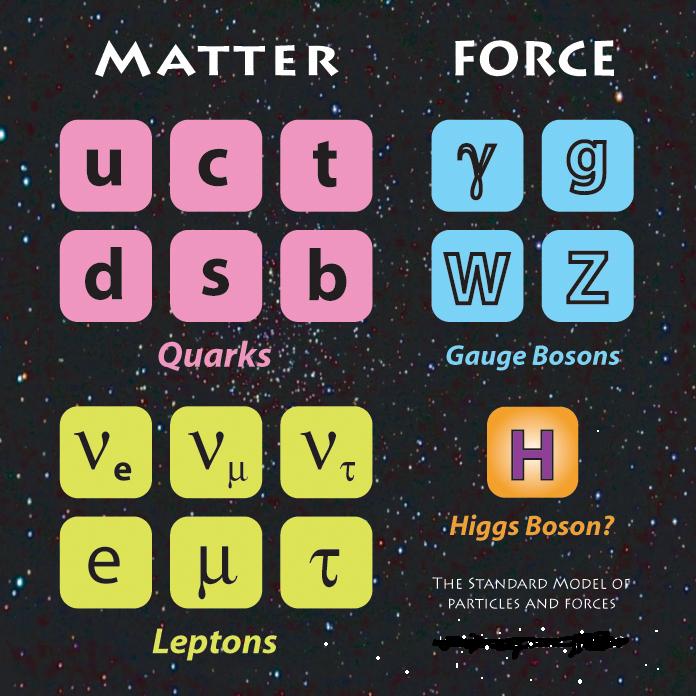

 |

|
Seemingly interminable delays in getting the world's largest particle accelerator, the Large Hadron Collider in Switzerland, into operation has given a smaller accelerator, the decades-old Tevatron at Fermi National Laboratory in the USA, a fighting chance to make one of the first great scientific discoveries of the 21st Century, by making and studying the Higgs Boson.
The purpose of colliders in physics is very, very simple to explain. At both the Tevatron and the LHC, proton beams moving in opposite directions with the largest kinetic energy possible are slammed directly into one another. By bringing a large kinetic energy into the collision, the accelerators become manufacturers of every kind of particle with a mass less than or equal to the total kinetic energy achieved. There are two kinds of particles in nature, fermions (like the electron and quarks), and bosons (like the photon). Matter is made of fermions... in fact all atoms are made of just three particles, up and down quarks, and electrons. In 1930 physicists learned from the relativistic quantum theory of fields that all forces in nature are “made of” bosons. That is, forces between fermions exist because near any fermion there is a finite probability of various bosons appearing spontaneously and temporarily carrying away kinetic energy and momentum. These bosons usually cease to exist quickly, but if and only if such a boson disappears near another fermion, its energy and momentum survive, transferred to the fermion.
The colliders turn such processes from
the off-chance into
an assembly line. Because of the many exact conserved quantities in
physics, fermions
can be made from kinetic energy only in particle-antiparticle pairs...
for example
a photon of sufficient kinetic energy, sufficiently near a charged
particle of some kind,
can convert into an electron-positron pair, or an
up-quark-anti-up-quark pair or any
other combination with no net charge (indeed, no net anything among
other similar conserved quantities) such that the two masses in energy
units equal to or are less than
the available kinetic energy. But for bosons, it's Katie Bar the Door,
because often all
the available kinetic energy can go into one single kind of
boson. Because of the various conservation laws, it's a bit
easier to make bosons if you collide protons and anti-protons, as the
Tevatron does, rather than colliding protons with protons, as the LHC
does.
|
Each fundamental force has its own set of bosons. For the electromagnetic force, the boson is the photon, γ. For the strong nuclear force that holds quarks together to form protons and neutrons, the bosons are the 8 gluons, g. For the weak nuclear force, responsible for converting up quarks to down quarks and vice versa, and thus for converting protons to neutrons and vice versa, the bosons are the two W bosons, and the Z0 boson. |

|
If you know anything about modern physics you might notice two big missing pieces. Where is the boson responsible for gravity? And where is the boson responsible for the recently discovered repulsive force, just slightly stronger than gravity, which causes the universe to accelerate in its expansion? Well, both of these forces are the weakest of all known forces, only about one part in 10 to the 40th power as compared to the strong nuclear force carried by gluons. Since the strength of the force is related to the probability of producing the boson, it should be clear that no imaginable accelerator has any chance of making bosons for these two very-long-range but very weak forces.
What the LHC and the Tevatron hope to be the first to make is the only particle that is part of the “Standard Model,” so called, and which has not yet been observed. This is the Higgs. What is it? Well, it's a key part of the Standard Model of matter and forces.
I haven't read any on-line “explanations” of the Higgs bosons that make sense according to physics, or even according to grammar, so let me make my own humble effort. Most of the mass we see in the universe that is carried by matter... ordinary protons, neutrons... is in fact due to the particle's internal energy, not to the mass of the things it's made of. Take the proton, for example. About 99% of its mass is due, not to the three quarks it is composed of, but due to its internal energy. Gluons are massless, but they carry so much kinetic energy and momentum inside the proton that only 1% of the observed proton mass is due to the two up quarks and one down quark it is supposedly made of.
But how about the particles in nature that are pointlike and not made of anything? Particles like the electron, the quarks, and the W and Z bosons? In the 1940s, physicists realized that existing theories of fundamental forces worked without mathematical pathologies only when all bosons and fermions had zero mass. Could it be that in fact all fundamental, pointlike bosons and fermions DO have zero mass? The Higgs field is a realization of that ideal. The Higgs has an unusual property that allows it to “lurk” in the ordinary vacuum. Any pointlike fundamental particle travelling in the vacuum must be constantly interacting with the Higgs field. It is precisely this interaction that, in the Standard Model, causes these massless fermions and bosons, including the Higgs itself, to appear to have mass. Because they find the Higgs field “sticky,” they propagate as if they had inertia, rather than being massless. Other particles, like the photon and the gluons, are not affected by the Higgs field and remain massless.
The Higgs field also had a role to play in the very early history of the universe... for the obvious reason that when the universe was less than 10−6 seconds old, it was denser than the interior of the proton is today, dominated by a “quark-gluon plasma,” which another giant collider, the Relativistic Heavy Ion Collider in New York State, has been studying for the past decade, and which the LHC is also now beginning to probe. The role the Higgs field played within this incredible soup of immense energy at immense density is a story for another science page. If you have ever had a course touching on modern cosmology, you will be aware of yet another field that can lurk in the vacuum, namely the inflation field. So if you are counting, that's three different scalar fields that are found in the ordinary vacuum: the Higgs field, the dark energy field, and the inflation field! Is it a surprise that there are three? Well, there seem to be three of almost everything, at the fundamental level, so it probably should not be not a surprise, but I still find it faintly disturbing... perhaps a warning of some missed connection in current fundamental physical theory.
By the way, as of fall 2011, the LHC
has been operating pretty much near capacity for a year, and
Fermilab found no Higgs at
the lower energies where it could look, and is currently shut down, and
so the race is over, and
everything now depends on the LHC.